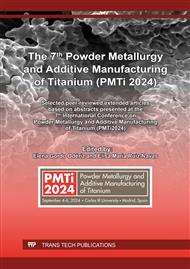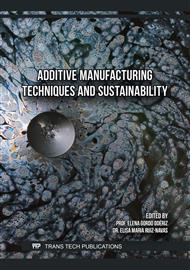p.23
p.29
p.41
p.49
p.59
p.69
p.79
p.89
p.97
Effect of the Scanning Speed and Powder Recycling Impact on Titanium Ti-6Al-4V Alloy by PBF – L/M
Abstract:
The main interest in Additive Manufacturing, specifically Powder Bed Fusion - Laser/Metal (PBF-L/M) technology relates to its ability to produce complex components with significant weight reduction using the minimum material required by the application. Being the aerospace sector one of the sectors where this technology has more interest and applications, particularly the Ti-6Al-4V alloy, ensuring the quality of parts thus the processed material becomes more critical since the criticality of the using powder affects directly.This study aims to analyze the effect of powder reuse on titanium alloy Ti‑6Al‑4V manufactured by PBF-L as well as the material processability when a significant processing parameters optimization is conducted by modifying the laser scan speed for the process efficiency by keeping the energy density without compromising the material performance. The chemical composition and the physical properties of specimens manufactured with virgin powder and after several build jobs are analyzed and compared to assess the influence of virgin and reused powder material on the consolidated material.Furthermore, the manuscript also provides perspectives and recommendations to enable AM users to develop a well-defined and standard powder reuse process to maintain the desired characteristics' consistency. By optimizing the laser parameters, both manufacturing efficiency and material behavior can be improved. Fatigue and tensile testing should be done too to prove this after several heat treatments in different conditions, to improve alloy properties and minimize residual stress at the same time.Finally, it is worth mentioning that the development carried out around this dual-phase Ti alloy has contributed to some parts manufacturing of structural components for aerospace applications. Hence, the material performance has a long journey ahead of that industry.
Info:
Periodical:
Pages:
59-65
Citation:
Online since:
March 2025
Authors:
Price:
Сopyright:
© 2025 Trans Tech Publications Ltd. All Rights Reserved
Share:
Citation:



